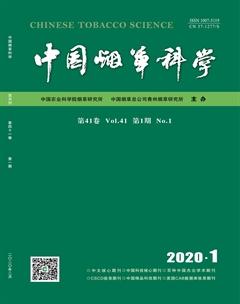蠋蝽对斜纹夜蛾幼虫的捕食作用
唐艺婷 王孟卿 李玉艳 刘晨曦 毛建军 陈红印 张礼生



摘 要:为明确蠋蝽对斜纹夜蛾的捕食能力,在实验室条件下进行蠋蝽3~5龄若虫及成虫对斜纹夜蛾3龄幼虫的捕食能力测试,数据采用HollingⅡ功能反应模型进行拟合以明确其捕食潜能,利用Hassell模型拟合并测定了蠋蝽自身密度对斜纹夜蛾捕食作用的影响。结果表明,蠋蝽3~5龄若虫及成虫对斜纹夜蛾幼虫的捕食模型均符合HollingⅡ模型;蠋蝽3~5龄若虫和成虫瞬时攻击率顺序是3龄(1.873)>雌成虫(1.329)>4龄(1.187)> 5龄(1.125)>雄成虫(0.828);蠋蝽雌成虫的日最大捕食量最大,为13.699头。随着斜纹夜蛾3龄幼虫密度增大,蠋蝽的搜寻效应逐渐降低,雌成虫的搜寻效应明显大于其他虫态。随着天敌蠋蝽密度增大,干扰增强,平均捕食量随之降低。本研究显示出蠋蝽雌成虫对斜纹夜蛾具有较大的捕食潜能。
关键词:蠋蝽;斜纹夜蛾;生物防治;功能反应
Predation ofArma chinensisonSpodoptera lituraLarvae
TANG Yiting, WANG Mengqing*, LI Yuyan, LIU Chenxi, MAO Jianjun, CHEN Hongyin, ZHANG Lisheng
(USDA-ARS Sino-American Biological Control Laboratory, Institute of Plant Protection, Chinese Academy of Agricultural Sciences, Beijing 100193, China)
Abstract: In order to know the parasitoidism ofArma chinensis onSpodoptera litura, the predation of 3-5 instar nymph and adult ofA.chinensisonS. liturawas studied in laboratory. Experimental data was fitted to the mathematical model HollingⅡ in which controlling effects were determined by parameters of preying potential capacity. The influences of the predators density functional response were determined by the mathematical model Hassell. The results showed that 3-5 instar nymph and adult predators exhibited Holling II functional responses, with the order of attacking efficiency being 3rd (1.873) >female (1.329) >4th(1.187) >5th(1.125)>male(0.828). The maximum daily predation number of female was 13.699. With the increase of preys density, predators searching effect decreases gradually, and the searching effect of female was obviously larger than that of other stages. As the density ofA. chinensissincreased, the interference was stronger and the average predation decreased. It indicated that femaleA. chinensishas a greater predation potential forS. litura.
Keywords:Arma chinensis;Spodoptera litura; biological control; functional response
斜纹夜蛾Spodoptera lituraFabricius属鳞翅目,夜蛾科,是一种间歇性发生的世界性害虫,在我国各地均有分布,为害严重。其幼虫取食烟草、葡萄、棉花、辣椒等多种寄主植物,近年来,斜纹夜蛾对烟草的危害尤为严重,对烟叶品质和产量影响较大,其幼虫啃食烟叶旺长期-采收期的中、下部,3龄后幼虫进入暴食期,可转移为害。严乃胜等[1]报道斜纹夜蛾在云南宾川烟草上大发生,发生严重的烟田被害植株率达90%以上,被害叶率在50%左右。利用生物防治的方法控制斜纹夜蛾符合国家绿色发展的要求,可提升烟叶品质。
目前已报道的防治斜纹夜蛾的捕食性天敌主要有红彩真猎蝽Harpactor fuscipes(Fabrieius),叉角厉蝽CantheconideaFurcellat(Walff),烟盲蝽Crytopeltis tenuis (Reuter),蜘蛛等[2-6]。蠋蝽Arma chinensis (Fallou)属于半翅目Hemiptera,蝽科Pentatomidae,益蝽亚科Asopinae,是一种优良的天敌昆虫,在我国多省均有分布,它的成虫和若虫均能够捕食多种鳞翅目、鞘翅目、双翅目等害虫的成虫和幼虫[7]。张晓军等[8]研究了蠋蝽对榆紫叶甲Ambrostoma quadriimopressum Motschlsky的捕食作用,充分显示了蠋蝽的捕食潜力。笔者也从田间和实验室观察到蠋蝽取食多种鳞翅目幼虫和成虫,如:二化螟Chilo suppressalis(Walker),甜菜夜蛾Spodoptera exiguaHübner,美国白蛾Hyphantria cunea(Drury),棉铃虫Helicoverpa armigera(Hübner),小菜蛾Plutella xylostella(L.)等。目前蠋蝽的人工飼料和大量饲养技术已经取得明显的进展[9-13],但是关于蠋蝽对斜纹夜蛾的捕食量数据目前还没有报道。
本研究結果表明,蠋蝽3~5龄若虫和成虫均有较强的捕食能力,且捕食模型符合HollingⅡ圆盘方程,这与其他捕食蝽对猎物的捕食功能反应模型一致[2-6,17]。数据表明,蠋蝽雌成虫处理斜纹夜蛾3龄幼虫的时间最短只需0.073 d,其日最大捕食量13.699头,控害效能为18.205,均较蠋蝽其他龄期以及雄成虫高,与张晓军等[8]研究结果蠋蝽捕食榆紫叶甲表现出蠋蝽5龄若虫的捕食量最大有所不同,但是和红彩真猎蝽[3],叉角厉蝽[4],蜘蛛[6]等研究结果一致,均是雌成虫对斜纹夜蛾表现出最大捕食量。
蠋蝽的攻击率顺序表现为:3龄若虫(1.873)>雌成虫(1.329)>4龄若虫(1.187)>5龄若虫(1.125)>雄成虫(0.828)。低龄若虫(3龄)最积极,可能是3龄蠋蝽若虫体积小,对于24 h的饥饿处理反应明显,急于捕食。成虫中雌虫的攻击率强于雄虫因为雌性成虫产卵需要更多的能量。
搜寻效应是捕食者在捕食过程中对寄主攻击的一种行为效应,其模型为S=aTr/(1+aThN)[15]。通常情况下,随着猎物密度增加,捕食者的搜寻效应会降低。本研究表明随着斜纹夜蛾密度的增大,蠋蝽搜寻效应逐渐降低。在相同猎物密度下,蠋蝽雌成虫对斜纹夜蛾的搜寻效应最大,搜寻能力较强。
蠋蝽3~5龄若虫及成虫捕食斜纹夜蛾平均捕食量,随着天敌密度的增加而降低。利用Hassell模型(A=aP-b)能较好地反映出蠋蝽自身密度的干扰效应。其中蠋蝽雌成虫对斜纹夜蛾3龄幼虫的捕食量最大,与上述捕食功能反应表现一致。蠋蝽5龄若虫和成虫的自身密度干扰系数相对较小,说明体积大的蠋蝽更倾向于单独捕食。
研究捕食者和猎物的相互作用有利于优化生防策略。本试验通过建立的蠋蝽对斜纹夜蛾的功能反应模型和自身密度干扰模型,明确了蠋蝽3~5龄若虫和成虫对斜纹夜蛾3龄幼虫的的捕食量,以实现利用最小的释放成本达到最佳的释放目的。但本试验是在室内,并且是在狭小的养虫盒内下完成,而自然条件下存在诸多因素(气候,温湿度,降雨量)影响捕食者的捕食作用,因此还需要在本研究的基础上,在田间进一步评价蠋蝽对斜纹夜蛾自然种群的控制能力。
4 结 论
根据本试验结果,蠋蝽对斜纹夜蛾具有一定的捕食能力,在理论上通过释放蠋蝽防治斜纹夜蛾是可行的。试验研究表明,蠋蝽5龄若虫和成虫对斜纹夜蛾具有较强的捕食能力,在田间应用时可多释放蠋蝽5龄若虫和成虫,尽快降低斜纹夜蛾种群数量,减少斜纹夜蛾对烟草的为害。
参考文献
[1] 严乃胜,罗佑珍,邱光鹏,等. 斜纹夜蛾的发育起温度和有效积温研究[J]. 云南农业大学学报,2000,15(1):21-23.
YAN N S, LUO Y Z, QIU G P, et al. Studies on development threshold temperature and effective temperature summation and themal constant of tobaccoSpodoptera litura[J]. Journal of Yunnan Agricultural University, 2000, 15(1): 21- 23.
- 谢建军,胡美英,许再福. 斜纹夜蛾的天敌及其生物防治[J]. 昆虫天敌,1999,21(2):82-92.
XIE J J, HU M Y, XU Z F. Nature enemies and biological control ofSpodoptera litura Fabricius. Nature Enemy of Insects, 1999, 21(2): 82-92.
- 邓海滨,王珍,陈永明,等. 红彩真猎蝽对斜纹夜蛾和烟青虫的捕食功能反应[J]. 广东农业科学,2012,39(13):107-109.
DENG H B, WANG Z, CHEN Y M, et al. Predation of Harpactor fuscipes on Helicoverpa assulta andSpodoptera litura[J]. Guangdong Agricultural Sciences, 2012, 39(13): 107-109.
- 陈然,梁广文,张拯研,等. 叉角厉蝽对斜纹夜蛾的捕食功能反应[J]. 环境昆虫学报,2015,37(2):401-406.
CHEN R, LIANG G W, ZHANG Z Y, et al. The functional response ofCahtheconidea furcellata(Hemiptera: Asopinae) toSpodoptera litura(Lepidoptera: Noctuidae)[J]. Jouranal of Environment Entomology, 2015, 37(2): 401-406.
- 官宝斌,陈家骅,陈乾锦,等. 烟盲蝽对斜纹夜蛾幼虫和烟蚜的捕食功能反应[J]. 中国烟草学报,1999,5(4):21-24.
GUAN B B, CHAN J H, CHEN Q J, et al. The predations capacity and functional response of Crytopeltis tenuis Renter to aphidius and larvae ofSpodoptera lituraFabricius[J]. Acta Tabacaria Sinica, 1999, 5(4): 21-24.
- 秦厚国,叶正襄,丁建,等. 两种蜘蛛对斜纹夜蛾捕食作用及模拟模型的研究[J]. 棉花学报,2002,14(2):126-129.
QIN H G, YE Z X, DING J, et al. Studies on predation and simulation models of two spider enemies onSpodoptera lituraFabricius[J]. Cotton Science, 2002, 14(2): 126-129.
- 邹德玉,徐维红,刘佰明,等. 天敌昆虫蠋蝽的研究进展与展望[J]. 环境昆虫学报,2016,38(4):857-865.
ZOU D Y, XU W H, LIU B M, et al. Research progress and prospects ofArma chinensisFallou (Hemiptera: Pentatomidae)[J]. Jouranal of Environment Entomology, 2016, 38 (4): 857-865.
- 张晓军,张健,孙守慧. 蠋蝽对榆紫叶甲的捕食作用[J]. 中国森林病虫,2016,35(1):13-15.
ZHANG X J, ZHANG J, SUN S H. Predation ofArma chinensis on Ambrostoma quadriimopressum[J]. Forest Pest and Disease, 2016, 35(1): 13-15.
- 潘明真,张海平,张长华,等. 饲养密度和性比对蠋蝽存活和繁殖生物学特性的影响[J]. 中国生物防治学报,2018,34(1):52-58.
PAN M Z, ZHANG H P, ZHANG C H, et al. Effect of rearing density and ratio of adultArma chinensis (Hemiptera: Pentatomidae) on their survl, fecundity and offsprings suitability[J]. Chinese Journal of Biological Control, 2018, 34(1): 52-58.
- 李娇娇,张长华,易忠经,等. 三种猎物对蠋蝽生长发育和繁殖的影响[J]. 中国生物防治学报,2016,32(5):552-561.
LI J J, ZHANG C H, YI Z J, et al. Effect of three prey species on development and fecundity of the predatory stinkbug Arma chinensis (Hemiptera: Pentatomidae)[J]. Chinese Journal of Biological Control, 2016, 32(5): 552 -561.
- ZOU D Y, COUDRON T A, LIU C, et al. Nutrigenomics in Arma chinensis: transcriptome analysis of Arma chinensis fed on artificial diet and Chinese oaksilk moth Antheraea pernyi pupae[J]. PLoS ONE, 2013, 8(4): e60881.
- 廖平,苗少明,許若男,等. 新型蠋蝽若虫液体人工饲料效果评价[J]. 中国生物防治学报,2019,35(1):9-14.
LIAO P, MIAO S M, XU R N, et al. Evaluation of a new liquid diet ofArma chinensis (Hemiptera: Pentatomidae) [J]. Chinese Journal of Biological Control, 2019, 35(1): 9-14.
- 张健,周毓麟,孙守慧. 利用人工饲料连代饲养蠋蝽若虫效果评价[J]. 中国森林病虫,2017,36(4):37-40.
ZHANG J, ZHOU Y L, SUN S H. Rearing ofArma chinensis (Hemiptera: Pentatomidae) on an artificial diet[J]. Forest Pest and Disease, 2017, 36(4): 37-40.
- HOLLING C S. Some characteristics of simple types of predation and parasitism[J]. The Canadian Entomologist, 1959, 91(7): 385-398.
- 丁巖钦. 昆虫数学生态学[M]. 北京:科学出版社,1994:257-258,303-304.
DING Q Y. Insect mathematical ecology[M]. Beijing: Science Press, 1994: 257-258, 303-304.
- HASSEL M P. A population model for the interaction between Cyzenisal bicans (Fall) (Tachinidae) and Opero phterabrumata(L.) (Geometridae) at Wytham, Berkshire[J]. Journal of Animal Ecology, 1969, 38(3): 567-576.
- 唐艺婷,郭义,何国玮,等. 不同龄期的益蝽对粘虫的捕食功能反应[J]. 中国生物防治学报,2018,34(6):825-830.
TANG Y T, GUO Y, HE G W, et al. Functional responses ofPicromerus lewisi Scott (Hemiptera: Pentatomidae) AttackingMythimna separata (Walker) (Lepidoptera: Noctuidae)[J]. Chinese Journal of Biological Control, 2018, 34(6): 825-830.

